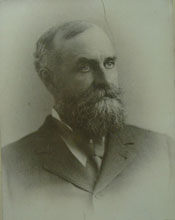Bay of Quinte Railway Reporting mark: unknown
The Bay of Quinte Railway (BQR) was a small regional line located in Hastings County. It began as the Napanee, Tamworth and Quebec Railway Company (NT&QR), first chartered in 1879. One of the major players in the charter application was the Rathbun family, based in Deseronto.

Deseronto Archives, ca. 1898
During the late 1800s the Rathbun Company had grown to become a major industrial empire. Based in eastern Ontario, their interests included lumbering, cement, brick yards, iron, railway construction and dockyards. Easy access to rail and water transportation was vital to both the success and expansion of their various operations. It was therefore no surprise when the Rathbuns extended their reach into the railway industry.
With funding uncertain, the NT&QR languished for a couple of years. In 1881 the Rathbuns took up the cause and kick-started the railway into high gear. The Rathbuns both financed and took over as contractors of the NT&QR. In 1883 they also took control of the Thousand Islands Railway, a similarly plagued railway about 100 km east. Both projects were completed in 1884. By 1889 the Rathbuns had extended the NT&QR to Tweed, which included both the Marmora iron ore mine and the Rathbun-owned portland cement plant in Marlbank.
In 1882 another Rathbun-owned company, the Bay of Quinte Railway and Navigation Company (BQR&NC), completed a four-mile (6.5 km) line to connect to the Grand Trunk Railway (GTR) from Deseronto where they had running rights into Napanee.
To simplify organization, the NT&QR (which by then had been renamed the Kingston, Napanee and Western Railway or KN&WR) was leased to the BQR&NC in 1891. In 1897 both railways were merged into a new entity, known as the Bay of Quinte Railway (BQR).
Corporate reorganization aside, expansion of the BQR continued unabated. In 1889, the railway extended its reach into Kingston with another four-mile link and running rights along the Kingston and Pembroke Railway (later CPR). An extension to Sydenham was completed in 1893. By the early 1900s, the company was looking northward to the mineral fields in central Hastings. An extension to Bannockburn through Queensborough, coupled with a connection to the Central Ontario Railway (COR) was completed in 1903. At its height, the railway stretched for 83 miles (134 km) from Harrowsmith to Bannockburn, and south to Napanee with 23 stations.
Changing markets, depletion of lumber reserves, and mill fires took their toll on the Rathbun Company. During the early 1900s, with their vast corporation collapsing, they began selling off assets.
The BQR, caught the eye of William Mackenzie and Donald Mann, owners of the Canadian Northern Railway (CNoR) which at the time was in the throes of massive expansion. In 1909, the CNoR gained control of the Irondale Bancroft & Ottawa Railway, followed by the BQR in 1910, and the COR in 1911. By then the CNoR enjoyed a dominant position in eastern Ontario. The BQR was to form part of the new CNoR mainline.
The CNoR lasted only a few short years. A victim of massive overbuilding and declining revenues during World War I, the railway fell to bankruptcy in 1918 and was nationalized by the Canadian Government. The Grand Trunk Railway met a similar fate in 1923 and both railways were consolidated under the Canadian National Railway (CN).
CN, like all railways was hit hard by declining revenues during the Great Depression. The railway responded by shutting down little-used and unprofitable lines. Much in the same way it started, the BQR was dismantled piece-by-piece. The section from Tweed to Bannockburn was shut down in 1935, followed by Yarker to Tweed in 1941. Deseronto to Napanee lasted until 1986.
Today, very little remains of the original BQR. Nine of the original 23 stations have survived. Most are now in use as private residences.
